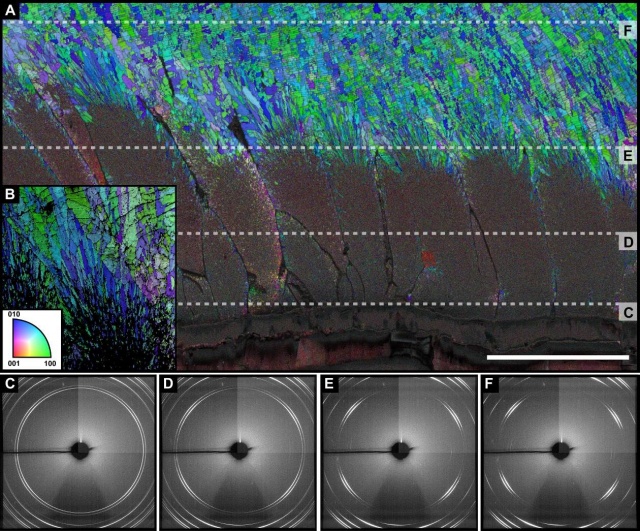Phase-field modelling and biomineralization: where materials science meets biology
Széchenyi Award winning László Gránásy who is a researcher at the Wigner Research Centre for Physics, of the Hungarian Academy of Sciences, Budapest and his computational materials science team in cooperation with the German scientists (Igor Zlotnikov’s team at the Center for Molecular Bioengineering of the Technische Universität Dresden) investigate how far the mathematical methods developed in materials science can be applied for modelling solidification processes in biological systems.
During biomineralization hierarchically structured organic-inorganic composites of unique properties form, where the unique properties originate from their microstructure. Examples for biomineralization are the formation of bones, teeth, kidney stones, and deposition of cholesterol on the walls of blood vessels, or the creation of diatom and mollusc shells, and coral-skeletons.

Credits: Schoeppler V., et al, Biomineralization as a Paradigm of Directional Solidification: A Physical Model for Molluscan Shell Ultrastructural Morphogenesis, First published: 21 September 2018, DOI: (10.1002/adma.201803855). Copyright Wiley-VCH Verlag GmbH & Co. KGaA. Reproduced with permission Credits: Schoeppler V., et al, Biomineralization as a Paradigm of Directional Solidification: A Physical Model for Molluscan Shell Ultrastructural Morphogenesis, First published: 21 September 2018, DOI: (10.1002/adma.201803855). Copyright Wiley-VCH Verlag GmbH & Co. KGaA. Reproduced with permission.)
Computational materials science is one of the important ingredients of knowledge based materials design. Analysing the solidification/crystallization of metals, polymers, plastics, and composites, etc. efficient modelling tools have been worked out in the past decades for describing complex solidification processes and the evolution of microstructure. A method of choice in this area is a specific version of the phase-field model developed by the Hungarian team that captures crystallization by using appropriate order parameters such as the phase-field that monitors the structural changes, the concentration field representing the local composition, and the orientation field that reflects the local crystallographic orientation.
In a paper that appeared on 21 September, 2018 in the high ranking scientific journal Advanced Materials (https://onlinelibrary.wiley.com/doi/abs/10.1002/adma.201803855), Hungarian and German scientists report a spectacular agreement between the microstructure of mollusc shells determined by experimental methods (including electron microscopy, electron back-scattering diffraction (EBSD), and X-ray micro-tomography performed at a synchrotron) and the microstructure predicted by the phase-field theory (cf. Figs. 1 and 2). Such a complex structure was addressed for the first time by phase-field modelling, which may open the way for the modelling of even more complex biomineralization processes. Although this is a fundamental research study, besides its biological interest, the knowledge gained may contribute to developing environment-friendly ambient temperature technologies for producing hierarchically structured composites.
 Cross-sectional electron back-scattering diffraction (EBSD) images for the shell of the freshwater mussel Unio Pictorum (by Igor Zlotnikov, B-Cube, Center for Molecular Bioengineering, Technische Universität Dresden). In the lower part of the cross-sectional image (the outer layer of the shell, C) randomly oriented fine crystallites can be seen, above which (D-E) a columnar structure develops that shows orientational ordering, whereas in the innermost layer (F) a layered structure (nacre) develops.
Cross-sectional electron back-scattering diffraction (EBSD) images for the shell of the freshwater mussel Unio Pictorum (by Igor Zlotnikov, B-Cube, Center for Molecular Bioengineering, Technische Universität Dresden). In the lower part of the cross-sectional image (the outer layer of the shell, C) randomly oriented fine crystallites can be seen, above which (D-E) a columnar structure develops that shows orientational ordering, whereas in the innermost layer (F) a layered structure (nacre) develops.(Credits: Schoeppler V., et al, Biomineralization as a Paradigm of Directional Solidification: A Physical Model for Molluscan Shell Ultrastructural Morphogenesis, First published: 21 September 2018, DOI: (10.1002/adma.201803855). Copyright Wiley-VCH Verlag GmbH & Co. KGaA. Reproduced with permission.)
This research was supported by the Frontline Excellence Program of the National Office of Research, Development and Innovation, Hungary.
Further information: http://www.esrf.eu/home/news/general/content-news/general/molluscs-use-thermodynamics-to-create-complex-morphologies-with-exceptional-properties.html
